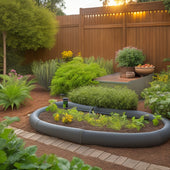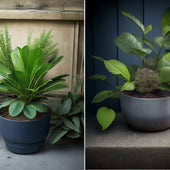
3 Best Pest Control Methods for Rooftop Fruit
Share
When growing rooftop fruit, you'll inevitably face pest problems, but combining natural deterrents, organic control methods, and advanced trapping techniques can protect your crop. For natural deterrents, try neem oil, garlic sprays, or companion planting with basil or marigolds. Organic methods involve using essential oils like neem and peppermint or creating homemade sprays or traps. Advanced trapping techniques require understanding pest attractants, like apple cider vinegar for fruit flies, and designing traps with visual cues to enhance effectiveness. By mastering these three approaches, you'll be well on your way to a pest-free harvest, and with further exploration, you'll uncover even more targeted solutions.
Key Takeaways
• Neem oil and diatomaceous earth serve as effective natural repellents for rooftop fruit pests, providing an environmentally friendly alternative to chemical pesticides.
• Companion planting with herbs like basil and marigolds can naturally deter pests like aphids, whiteflies, and nematodes from fruit trees.
• Essential oils like neem and peppermint possess natural insecticidal properties, making them ideal for creating homemade sprays or traps for pest control.
• Designing traps that consider pest attractants, size, and mobility can effectively capture rooftop fruit pests, such as fruit flies and aphids.
• Using visual cues like color and shape can enhance trap attractiveness and increase effectiveness in rooftop fruit pest control.
Natural Deterrents for Fruit Pests
When protecting your rooftop fruit from pests, you can effectively utilize natural deterrents, such as neem oil and diatomaceous earth, to repel unwanted insects and prevent damage. These natural deterrents are a great alternative to chemical pesticides, as they're environmentally friendly and won't harm your fruit or the beneficial insects.
Herbal sprays, for instance, can be made by infusing herbs like garlic, chili peppers, or mint in water. These sprays can be applied directly to the fruit to repel pests.
Another approach is companion planting, where you plant certain herbs or flowers alongside your fruit trees to deter pests. For example, basil repels aphids and whiteflies, while marigolds repel nematodes.
Organic Pest Control Methods
You can take your rooftop fruit protection to the next level by incorporating organic pest control methods that offer targeted solutions to specific pest problems.
Companion planting is a clever way to deter pests naturally. By planting certain herbs and flowers alongside your fruit trees, you can repel pests without harming the environment. For example, basil repels aphids and whiteflies, while marigolds deter nematodes.
Essential oils can also be used to create potent pest control solutions. Certain oils, such as neem and peppermint, have natural insecticidal properties that can be used to create sprays or traps. You can also use essential oils to create a barrier around your fruit trees, preventing pests from reaching them.
When using essential oils, be sure to dilute them with water according to the recommended ratio to avoid damaging your plants.
Advanced Trapping Techniques
Take your rooftop fruit protection to the next level by leveraging advanced trapping techniques that capitalize on pests' natural behaviors and habits.
By understanding the attractants and motivators of common rooftop fruit pests, you can design traps that exploit these vulnerabilities. For instance, fruit flies are drawn to sweet, fermented, or decaying substances, making them ideal lure materials for traps. You can create a homemade trap using a jar, some apple cider vinegar, and a funnel to direct the flies inside.
When it comes to trap design, consider the pest's size, shape, and mobility. For example, smaller traps with narrow entrances can effectively capture aphids and whiteflies, while larger traps with wider openings can accommodate bigger pests like fruit moths.
Additionally, incorporating visual cues like color, shape, and pattern can enhance the trap's attractiveness to the target pest. By fine-tuning your trap design and lure materials, you can increase the effectiveness of your rooftop fruit protection and reduce pest populations.
With advanced trapping techniques, you'll be well on your way to enjoying a bountiful harvest free from pest damage.
Frequently Asked Questions
Can Rooftop Fruit Be Insured Against Pest Damage and Loss?
You can explore insurance options to protect your rooftop fruit from pest damage and loss, as some insurance policies specifically cover crop damage due to pests, providing financial security for your rooftop harvest.
How Often Should Rooftop Fruit Trees Be Pruned to Prevent Pest Issues?
You'll want to prune your rooftop fruit trees regularly, ideally during dormant seasons, using precise pruning techniques to promote air circulation and reduce pest habitats, ensuring a healthy harvest and minimizing pest issues.
Are Rooftop Fruit Pests Attracted to Specific Fruit Varieties?
You'll find that 75% of rooftop fruit pests are attracted to sweet, juicy varieties like peaches and plums. Notably, certain fruit varieties, such as bitter melon, naturally deter pests, making them a great companion plant choice.
Can Rooftop Fruit Be Grown in Greenhouses to Avoid Pests?
You can grow rooftop fruit in greenhouses, leveraging the controlled environment to prevent pest infestations and optimize growing conditions, thereby reaping the benefits of greenhouse benefits and effective pest prevention.
Do Rooftop Fruit Pests Pose a Risk to Human Health?
You uncover the unsettling truth: rooftop fruit pests pose a perilous threat to your health, as they facilitate pest transmission, triggering severe health effects, including allergic reactions, respiratory issues, and even infectious diseases, demanding vigilance and proactive measures.
Related Posts
-

Irrigation Solutions for Raised Bed Planters Made Easy
You can optimize your raised bed planters' irrigation system by understanding the complex interplay between soil type...
-

Irrigation Solutions for Raised Bed Planters Made Easy
You can optimize your raised bed planters' irrigation system by understanding the complex interplay between soil type...
-

Irrigation Solutions for Raised Bed Planters Made Easy
You can optimize your raised bed planters' irrigation system by understanding the complex interplay between soil type...
-

Irrigation Solutions for Raised Bed Planters Made Easy
You can optimize your raised bed planters' irrigation system by understanding the complex interplay between soil type...
-

Irrigation Solutions for Raised Bed Planters Made Easy
You can optimize your raised bed planters' irrigation system by understanding the complex interplay between soil type...
-

Irrigation Solutions for Raised Bed Planters Made Easy
You can optimize your raised bed planters' irrigation system by understanding the complex interplay between soil type...
-

Irrigation Solutions for Raised Bed Planters Made Easy
You can optimize your raised bed planters' irrigation system by understanding the complex interplay between soil type...
-

Irrigation Solutions for Raised Bed Planters Made Easy
You can optimize your raised bed planters' irrigation system by understanding the complex interplay between soil type...
-

Irrigation Solutions for Raised Bed Planters Made Easy
You can optimize your raised bed planters' irrigation system by understanding the complex interplay between soil type...
-

Irrigation Solutions for Raised Bed Planters Made Easy
You can optimize your raised bed planters' irrigation system by understanding the complex interplay between soil type...
-

Irrigation Solutions for Raised Bed Planters Made Easy
You can optimize your raised bed planters' irrigation system by understanding the complex interplay between soil type...
-

Irrigation Solutions for Raised Bed Planters Made Easy
You can optimize your raised bed planters' irrigation system by understanding the complex interplay between soil type...
-

Irrigation Solutions for Raised Bed Planters Made Easy
You can optimize your raised bed planters' irrigation system by understanding the complex interplay between soil type...
-

Irrigation Solutions for Raised Bed Planters Made Easy
You can optimize your raised bed planters' irrigation system by understanding the complex interplay between soil type...
-

Irrigation Solutions for Raised Bed Planters Made Easy
You can optimize your raised bed planters' irrigation system by understanding the complex interplay between soil type...
-

Irrigation Solutions for Raised Bed Planters Made Easy
You can optimize your raised bed planters' irrigation system by understanding the complex interplay between soil type...
-

Irrigation Solutions for Raised Bed Planters Made Easy
You can optimize your raised bed planters' irrigation system by understanding the complex interplay between soil type...
-

Irrigation Solutions for Raised Bed Planters Made Easy
You can optimize your raised bed planters' irrigation system by understanding the complex interplay between soil type...
-

Irrigation Solutions for Raised Bed Planters Made Easy
You can optimize your raised bed planters' irrigation system by understanding the complex interplay between soil type...
-

Irrigation Solutions for Raised Bed Planters Made Easy
You can optimize your raised bed planters' irrigation system by understanding the complex interplay between soil type...
-

Irrigation Solutions for Raised Bed Planters Made Easy
You can optimize your raised bed planters' irrigation system by understanding the complex interplay between soil type...
-

Irrigation Solutions for Raised Bed Planters Made Easy
You can optimize your raised bed planters' irrigation system by understanding the complex interplay between soil type...
-

Irrigation Solutions for Raised Bed Planters Made Easy
You can optimize your raised bed planters' irrigation system by understanding the complex interplay between soil type...
-

Irrigation Solutions for Raised Bed Planters Made Easy
You can optimize your raised bed planters' irrigation system by understanding the complex interplay between soil type...
-

Irrigation Solutions for Raised Bed Planters Made Easy
You can optimize your raised bed planters' irrigation system by understanding the complex interplay between soil type...
-

Irrigation Solutions for Raised Bed Planters Made Easy
You can optimize your raised bed planters' irrigation system by understanding the complex interplay between soil type...
-

Irrigation Solutions for Raised Bed Planters Made Easy
You can optimize your raised bed planters' irrigation system by understanding the complex interplay between soil type...
-

Irrigation Solutions for Raised Bed Planters Made Easy
You can optimize your raised bed planters' irrigation system by understanding the complex interplay between soil type...
-

What's the Ideal Timeline for a Concrete Planter Reno
You'll need to allocate around 6-12 weeks for a concrete planter renovation, broken down into seven distinct phases t...
-

What's the Ideal Timeline for a Concrete Planter Reno
You'll need to allocate around 6-12 weeks for a concrete planter renovation, broken down into seven distinct phases t...
-

What's the Ideal Timeline for a Concrete Planter Reno
You'll need to allocate around 6-12 weeks for a concrete planter renovation, broken down into seven distinct phases t...
-

What's the Ideal Timeline for a Concrete Planter Reno
You'll need to allocate around 6-12 weeks for a concrete planter renovation, broken down into seven distinct phases t...
-

What's the Ideal Timeline for a Concrete Planter Reno
You'll need to allocate around 6-12 weeks for a concrete planter renovation, broken down into seven distinct phases t...
-

What's the Ideal Timeline for a Concrete Planter Reno
You'll need to allocate around 6-12 weeks for a concrete planter renovation, broken down into seven distinct phases t...
-

What's the Ideal Timeline for a Concrete Planter Reno
You'll need to allocate around 6-12 weeks for a concrete planter renovation, broken down into seven distinct phases t...
-

What's the Ideal Timeline for a Concrete Planter Reno
You'll need to allocate around 6-12 weeks for a concrete planter renovation, broken down into seven distinct phases t...
-

What's the Ideal Timeline for a Concrete Planter Reno
You'll need to allocate around 6-12 weeks for a concrete planter renovation, broken down into seven distinct phases t...
-

What's the Ideal Timeline for a Concrete Planter Reno
You'll need to allocate around 6-12 weeks for a concrete planter renovation, broken down into seven distinct phases t...
-

What's the Ideal Timeline for a Concrete Planter Reno
You'll need to allocate around 6-12 weeks for a concrete planter renovation, broken down into seven distinct phases t...
-

What's the Ideal Timeline for a Concrete Planter Reno
You'll need to allocate around 6-12 weeks for a concrete planter renovation, broken down into seven distinct phases t...
-

What's the Ideal Timeline for a Concrete Planter Reno
You'll need to allocate around 6-12 weeks for a concrete planter renovation, broken down into seven distinct phases t...
-

What's the Ideal Timeline for a Concrete Planter Reno
You'll need to allocate around 6-12 weeks for a concrete planter renovation, broken down into seven distinct phases t...
-

What's the Ideal Timeline for a Concrete Planter Reno
You'll need to allocate around 6-12 weeks for a concrete planter renovation, broken down into seven distinct phases t...
-

What's the Ideal Timeline for a Concrete Planter Reno
You'll need to allocate around 6-12 weeks for a concrete planter renovation, broken down into seven distinct phases t...
-

What's the Ideal Timeline for a Concrete Planter Reno
You'll need to allocate around 6-12 weeks for a concrete planter renovation, broken down into seven distinct phases t...
-

What's the Ideal Timeline for a Concrete Planter Reno
You'll need to allocate around 6-12 weeks for a concrete planter renovation, broken down into seven distinct phases t...
-

What's the Ideal Timeline for a Concrete Planter Reno
You'll need to allocate around 6-12 weeks for a concrete planter renovation, broken down into seven distinct phases t...
-

What's the Ideal Timeline for a Concrete Planter Reno
You'll need to allocate around 6-12 weeks for a concrete planter renovation, broken down into seven distinct phases t...
-

What's the Ideal Timeline for a Concrete Planter Reno
You'll need to allocate around 6-12 weeks for a concrete planter renovation, broken down into seven distinct phases t...
-

What to Know Before Upcycling Concrete Planters
When upcycling concrete planters, you'll want to start by evaluating the planter's size, shape, and condition to guar...
-

What to Know Before Upcycling Concrete Planters
When upcycling concrete planters, you'll want to start by evaluating the planter's size, shape, and condition to guar...
-

What to Know Before Upcycling Concrete Planters
When upcycling concrete planters, you'll want to start by evaluating the planter's size, shape, and condition to guar...
-

What to Know Before Upcycling Concrete Planters
When upcycling concrete planters, you'll want to start by evaluating the planter's size, shape, and condition to guar...
-

What to Know Before Upcycling Concrete Planters
When upcycling concrete planters, you'll want to start by evaluating the planter's size, shape, and condition to guar...
-

What to Know Before Upcycling Concrete Planters
When upcycling concrete planters, you'll want to start by evaluating the planter's size, shape, and condition to guar...
-

What to Know Before Upcycling Concrete Planters
When upcycling concrete planters, you'll want to start by evaluating the planter's size, shape, and condition to guar...
-

What to Know Before Upcycling Concrete Planters
When upcycling concrete planters, you'll want to start by evaluating the planter's size, shape, and condition to guar...
-

What to Know Before Upcycling Concrete Planters
When upcycling concrete planters, you'll want to start by evaluating the planter's size, shape, and condition to guar...
-

What to Know Before Upcycling Concrete Planters
When upcycling concrete planters, you'll want to start by evaluating the planter's size, shape, and condition to guar...
-

What to Know Before Upcycling Concrete Planters
When upcycling concrete planters, you'll want to start by evaluating the planter's size, shape, and condition to guar...
-

What to Know Before Upcycling Concrete Planters
When upcycling concrete planters, you'll want to start by evaluating the planter's size, shape, and condition to guar...
-

What to Know Before Upcycling Concrete Planters
When upcycling concrete planters, you'll want to start by evaluating the planter's size, shape, and condition to guar...
-

What to Know Before Upcycling Concrete Planters
When upcycling concrete planters, you'll want to start by evaluating the planter's size, shape, and condition to guar...
-

What to Know Before Upcycling Concrete Planters
When upcycling concrete planters, you'll want to start by evaluating the planter's size, shape, and condition to guar...
-

What to Know Before Upcycling Concrete Planters
When upcycling concrete planters, you'll want to start by evaluating the planter's size, shape, and condition to guar...
-

What to Know Before Upcycling Concrete Planters
When upcycling concrete planters, you'll want to start by evaluating the planter's size, shape, and condition to guar...
-

What to Know Before Upcycling Concrete Planters
When upcycling concrete planters, you'll want to start by evaluating the planter's size, shape, and condition to guar...
-

What to Know Before Upcycling Concrete Planters
When upcycling concrete planters, you'll want to start by evaluating the planter's size, shape, and condition to guar...
-

What to Know Before Upcycling Concrete Planters
When upcycling concrete planters, you'll want to start by evaluating the planter's size, shape, and condition to guar...
-

What to Know Before Upcycling Concrete Planters
When upcycling concrete planters, you'll want to start by evaluating the planter's size, shape, and condition to guar...
-

What to Know Before Upcycling Concrete Planters
When upcycling concrete planters, you'll want to start by evaluating the planter's size, shape, and condition to guar...
-

What to Know Before Upcycling Concrete Planters
When upcycling concrete planters, you'll want to start by evaluating the planter's size, shape, and condition to guar...


